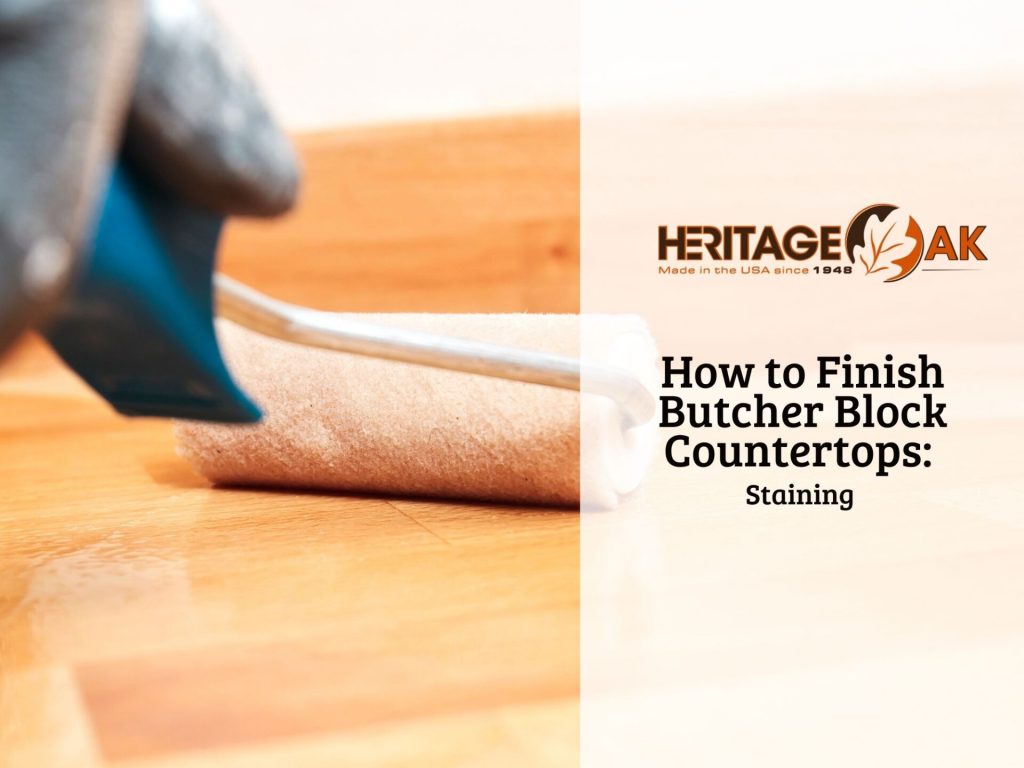
Butcher block countertops are a popular choice for many homeowners due to their natural and warm appearance. However, you may wonder if it's possible to stain these countertops to enhance their beauty and protect them. In this comprehensive guide, let's explore the different aspects of staining butcher block countertops.
Can You Stain Butcher Block Countertops?
Using stains as a finish is usually recommended against, especially for butcher block countertops in the kitchen. There are food-safe sealants to protect the stain (and food from absorbing any chemicals). However, it’s more challenging to preserve the color and appearance of stained butcher block countertop while using it every day. Compared to natural, food-safe oil, wear and tear will be much more noticeable on stain finishes. That being said, many homeowners have found a variety of uses for butcher block countertops outside of their kitchen. Therefore, food safety and daily cleaning isn’t a factor that opens up the possibilities of other finishes.
What to Know about Staining Butcher Block Countertop
Advantages of Staining Butcher Block Countertops:
- Enhances the hardwood’s natural beauty by adding color and depth
- Creates a visually appealing focal point, regardless of which room it’s placed in
- Allows homeowners to customize the appearance of their countertops
- Protects the wood from water damage and stains
- Increases the resistance to wear and tear of everyday use
- Extends the lifespan of the countertops
Disadvantages of Staining Butcher Block Countertops:
- Achieving an even appearance with stains is very challenging
- Improper cleaning and maintenance can cause the stain to fade or change color
While staining offers numerous benefits, it's important to be aware of the potential drawbacks. Ultimately, the decision to stain your butcher block countertops depends on your personal preferences and priorities. If you value the ability to customize the look of your countertops and want added protection against moisture and stains, staining can be a great option. However, it's important to carefully consider the potential challenges and commit to proper maintenance to ensure the longevity and beauty of your stained butcher block countertops.
Selecting Color
When selecting a stain for butcher block countertops, both the finished color and the type of wood are important. As different stains can produce varying shades and tones, it's recommended to test the stain on a small, inconspicuous area first. This allows you to see how the stain interacts with the wood and gives you an idea of the final color.
Opt for a stain specifically designed for wood surfaces and choose a brand known for its durability and color consistency. This ensures the stain will penetrate the wood effectively and provide long-lasting protection against wear and tear.
Refinishing Butcher Block Countertops
Over time, the stain on your butcher block countertops may start to fade or wear off in high-traffic areas. When this occurs, it's time to refinish your countertops. Start by sanding off the existing stain and then follow the staining process outlined earlier in this guide. Refinishing your stained countertops will not only revive their appearance but also provide an opportunity to change the stain color if desired.
How to Finish Butcher Block Countertops: Staining Process
- Clean Surface: Start by thoroughly cleaning your countertops to remove any dirt, grease, or residue.
- Preparing the Surface: Once clean, sand it gently with fine-grit sandpaper along the wood grain to remove any blemishes without damaging the surface. Sanding helps to create a smooth and even surface, allowing the stain to penetrate evenly. Sanding also helps to open up the pores of the wood, allowing the stain to penetrate deeper and achieve a richer color. After sanding, remove any dust or debris from the surface.
- Staining: Before applying the stain, make sure to read and follow the manufacturer's instructions carefully. Some stains may require multiple coats or specific application techniques to achieve the desired result. Apply a small amount of stain to a clean, lint-free cloth or brush. Apply the stain evenly, following the wood grain. Allow time for the stain to soak into the wood according to the instructions. Ensure any excess is wiped off with a clean cloth to achieve a uniform color.
- Drying: Allow the countertop to dry completely and cure according to the manufacturer's instructions. This process typically takes several hours or overnight.
- Add a Sealant: To protect the wood (and the stain) further, add a coat or two of wood stain sealant after the stain has cured.
Do Butcher Block Countertops Add Value?
Regardless of how you use a butcher block countertop, you can be sure that you are investing in a timeless and versatile surface that will enhance the beauty and functionality of your kitchen or workspace. With proper care and maintenance, butcher block countertops can last for many years, providing a durable and visually appealing surface for all your culinary adventures. At Heritage Oak, we offer a wide variety of locally-sourced, beautiful hardwood products! From hardwood stair parts to butcher blocks and more, our hardwood experts can help with all of your hardwood needs. Contact us today to learn more about our products and services!